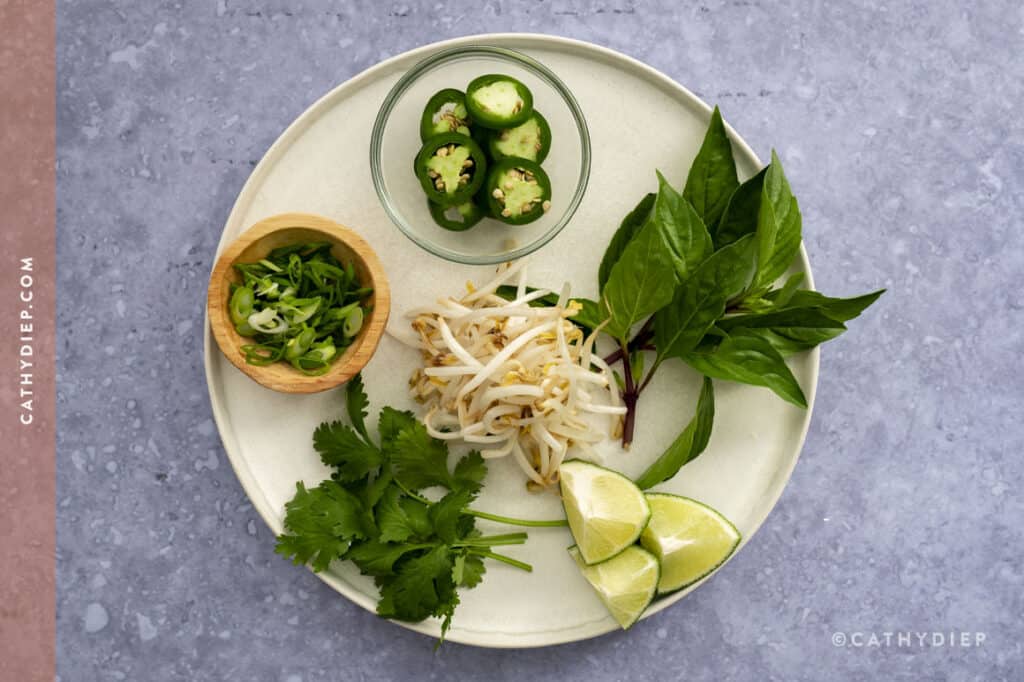What’s the difference between Thai basil and regular basil? Many people don’t know the difference, so we’re diving into the topic of basil varieties, differences, similarities, and what you can create with it.

This post may contain affiliate links. Please read my disclaimer.
What Is Thai Basil?
Thai basil is the variety you see most often in Southeast Asian cuisine. It has thick leaves that remain intact during the cooking process.
Thai basil is distinguishable by its purple flowers, narrow leaves, purple stems, and slightly serrated edges.
It offers a bold, slightly spicy flavor to dishes. When using Thai basil in recipes, you can expect an anise-like taste.
This herb is one that you can use raw or in cooked dishes, making it very versatile.
What Is Regular Basil?
Regular basil goes by many names, including sweet basil, Italian basil, Italian sweet basil, and simply basil.
It’s the most common variety seen in grocery stores in America, both as a fresh herb and dried. You have likely used this type of basil at least once, as it appears in many Italian recipes and Italian seasoning.
Regular basil has a thinner leaf that offers dishes a milder flavor. It’s sweet (hence the name sweet basil), minty, peppery, and slightly licorice-like in taste.
You can use basil raw or in cooked dishes. However, since it has a more delicate leaf, it’s best only to add it to cooked dishes at the very end.
The Differences
1. Appearance
They are pretty different in appearance. Regular basil has much larger leaves that typically appear rounded since they are more delicate. Thai basil leaves usually appear flat as they’re much denser.
2. Flavor
The flavor between these two basil varieties is also quite different. Thai basil has a much stronger taste than regular basil. They also offer different flavor notes when you add them to dishes.
3. Aroma
Both basil varieties have slightly different aromas. Thai basil offers a more robust, somewhat spicy anise and licorice scent. In comparison, regular basil has a sweet, minty, slightly licorice-like smell.
The Similarities
There are a few that these basil varietals share, including:
1. Fresh Herbs
Both are varieties of fresh herbs that you can use to help add aromatics and flavor to dishes.
2. The Mint Family
Each type of basil is part of the mint family, also known as Lamiaceae. Plants in this family all have simple leaves, square stems, and two-lipped flowers.
3. Versatility
Fresh Thai basil leaves and sweet basil leaves (along with their dried counterparts) are versatile in their uses, as you can add them to sauces, noodle dishes, and more.
What You Can Create With Thai Basil

There are a few ways to use Thai basil leaves at home; here are a few options.
- Pho and other noodle dishes: Fresh Thai basil is a typical pho garnish, helping to add a delicious fresh flavor to the soup, as well as other Asian noodle dishes.
- Thai Basil Chicken: It’s a popular street food that’s spicy, salty, and flavorful.
- Sauces: Pesto is an excellent example of an Asian sauce you can create with this fresh herb.
You May Also Like:
What You Can Create With Sweet Basil
Sweet basil is very versatile. Here are some common ways you’ll see sweet basil in use.
- Pizza: It’s a common topping on Margherita pizzas with fresh tomatoes and mozzarella.
- Sauces: Pesto (using regular basil) is a popular sauce for pasta dishes, chicken recipes, and more.
- Salads: Caprese salad is a delicious, simple option with fresh tomatoes, mozzarella, and basil leaves.
- Pasta: You’ll find this herb in various types of pasta, including marinara pasta.
Other Types of Edible Basil Plants
Many edible basil plants are available to help add aromatics and flavor to your dishes. Below are some of the most common types that you might find in specialty grocery stores.
Lemon Basil
Lemon basil is more commonly available than some of the other varieties below. It has a delicious summery lemon flavor. It’s excellent for salads, fish dishes, and even iced tea.
Cinnamon Basil
This basil variety has a sweet aroma and spicy flavor. It works well with fruit dishes, including desserts.
Holy Basil
Also known as tulsi, this variety is sacred in the Hindu religion and originates in India. However, it’s also a common ingredient in Thai cuisine. Many people also drink holy basil as a tea for its health benefits.
Genovese Basil
Genovese basil is another variety of Italian basil. It offers a more potent fragrance than Italian basil and a sweet, spicy flavor. Use it in any recipe that you would typically use regular basil.
Can You Substitute Sweet Basil in Thai Basil Recipes?
The short answer to this question is yes, though you’ll notice a difference in flavor and aroma. Using sweet basil will also require a few other modifications, like adding fresh sprigs of mint to help boost the flavor.
Also, remember that this swap may not be ideal for all recipes since regular basil has a much more delicate leaf.
The Takeaway
While Thai basil and regular basil are both in the same plant family, they each offer a unique flavor and aroma to dishes.
These fresh herbs are fantastic to have in the kitchen for you to experiment with, especially if you enjoy creating Italian and Asian cuisine. Let me know if you have a favorite!
Other Guides You May Also Be Interested In:
- Pad Thai vs Pho: What Are the Differences and Similarities?
- 10 Health Benefits of Kimchi You Probably Didn’t Know
- How Much Rice to Cook Per Person?

